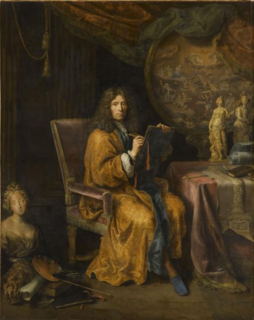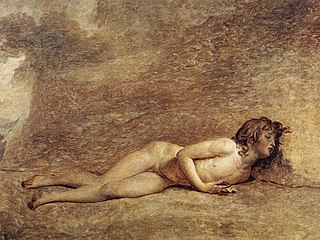Related Research Articles

The Isabella Stewart Gardner Museum is an art museum in Boston, Massachusetts, which houses significant examples of European, Asian, and American art. Its collection includes paintings, sculpture, tapestries, and decorative arts. It was founded by Isabella Stewart Gardner, whose will called for her art collection to be permanently exhibited "for the education and enjoyment of the public forever".

Pierre Mignard or Pierre Mignard I, called "Mignard le Romain" to distinguish him from his brother Nicolas Mignard, was a French painter known for his religious and mythological scenes and portraits. He was a near-contemporary of the Premier Peintre du Roi Charles Le Brun with whom he engaged in a bitter, life-long rivalry.

Jean-Jacques Henner was a French painter, noted for his use of sfumato and chiaroscuro in painting nudes, religious subjects, and portraits.

Paris Bordone was an Italian painter of the Venetian Renaissance who, despite training with Titian, maintained a strand of Mannerist complexity and provincial vigor.

Giovanni Battista Cima, also called Cima da Conegliano, was an Italian Renaissance painter, who mostly worked in Venice. He can be considered part of the Venetian school, though he was also influenced by Antonello da Messina, in the emphasis he gives to landscape backgrounds and the tranquil atmosphere of his works. Once formed his style did not change greatly. He mostly painted religious subjects, often on a small scale for homes rather than churches, but also a few, mostly small, mythological ones.
Sir Philip Anstiss Hendy was a British art curator who worked both in Britain and overseas, notably the United States. In 1923 he began his career in art administration as an Assistant Keeper and lecturer at the Wallace Collection in London, despite his having no formal training in art history. His entries for the Wallace Collection's new catalogue and articles for The Burlington Magazine so impressed the administration of the Isabella Stewart Gardner Museum in Boston, Massachusetts that the trustees of the museum agreed to fund Hendy's three-year stay in Italy, during which he compiled the Gardner catalogue.

Isabella Stewart Gardner was a leading American art collector, philanthropist, and patron of the arts. She founded the Isabella Stewart Gardner Museum in Boston.

Louis Kronberg (1872–1965) was an American figure painter, art dealer, advisor, and teacher. Among his best-known works are Behind the Footlights and The Pink Sash.

Bartolo di Fredi, also called Bartolo Battiloro, was an Italian painter, born in Siena, classified as a member of the Sienese School.

Esprit Calvet was a French physician and collector.

La Fondation Calvet is an art foundation in Avignon, France, named for Esprit Calvet, who left his collections and library to it in 1810. The foundation maintains several museums and two libraries, with support from the town. The original legacies of paintings, archaeological items, coins and medals, and medieval sculpture have been added to by many other legacies, and a significant deposit of works of art from the Louvre. The archaeological collections and medieval sculpture are now housed separately in the "Musée Lapidaire" - once the chapel of the Jesuit College. The main museum is in an 18th-century city mansion, to which modern buildings have been added; the Library bequeathed by Calvet, and the important collection of over 12,000 coins and medals, have moved to a different location in the city.

Josse Lieferinxe was a South Netherlandish painter, formerly known by the pseudonym the Master of St. Sebastian.

Jean-Michel Othoniel is a French contemporary artist born in 1964 in Saint-Etienne. He lives and works in Paris.

The Musée du Petit Palais is a museum and art gallery in Avignon, southern France. It opened in 1976 and has an exceptional collection of Renaissance paintings of the Avignon school as well as from Italy, which reunites many "primitives" from the collection of Giampietro Campana. It is housed in a 14th-century building at the north side of the square overlooked by the Palais des Papes. The building, built in the early 14th century as the residence of the bishops of Avignon, was made a UNESCO World Heritage Site as part of the historic center of Avignon in 1995.

Ibrahim Shahda was a figurative French painter born in Egypt.

Pietà of Villeneuve-lès-Avignon is an oil painting of the mid-15th century that is considered one of the outstanding works of art of the late Middle Ages. Following its appearance at an exhibition in 1904 its authorship was disputed, though it has since been accepted as the work of Enguerrand Quarton. It is now in the Musée du Louvre.

Claude-Marie-Paul Dubufe (1790–1864) a French historical, genre and portrait painter, was born in Paris in 1790, and studied under Jacques-Louis David. His subjects were at first classical, and then scriptural. He then gave himself up to the painting of genre pictures and portraits. His reputation rests chiefly on his portraits, of which he produced a large number. Dubufe, who was the last representative of the school of David, died at Selle-Saint-Cloud in 1864.

The Rape of Europa is a painting by the Venetian artist Titian, painted ca. 1560–1562. It is in the permanent collection of the Isabella Stewart Gardner Museum of Boston, Massachusetts. The oil-on-canvas painting measures 178 by 205 centimetres.

The Death of Young Bara, Joseph Bara or The Death of Bara is an incomplete 1794 painting by the French artist Jacques-Louis David, now in the musée Calvet in Avignon. Joseph Bara, a young drummer in the army of the French First Republic, was killed by the Vendéens. He became a hero and martyr of the French Revolution and – with The Death of Marat and The Last Moments of Michel Lepeletier – the painting formed part of a series by David showing such martyrs. There is also an anonymous contemporary copy dating to 1794, now in the Palais des Beaux-Arts de Lille and exhibited at the Musée de la Révolution française.

The Calvet Museum is the main museum in Avignon. Since the 1980s the collection has been split between two buildings, with the fine arts housed in an 18th-century hôtel particulier and a separate Lapidary Museum in the former chapel of the city's Jesuit college on rue de la République. It is one of the museums run by the Fondation Calvet.
References
- 1 2 (in French) Odile Cavalier, 'Une Stèle Funéraire Grecque Inéite au Musée Calvet d'Avignon', Revue Archéologique, Nouvelle Série, Fasc. 1 (1984), pp. 53-64
- ↑ "Paris Bordone, Christ Disputing in the Temple". Isabella Stewart Gardner Museum.
- ↑ "Marchesa Balbi". www.nga.gov.